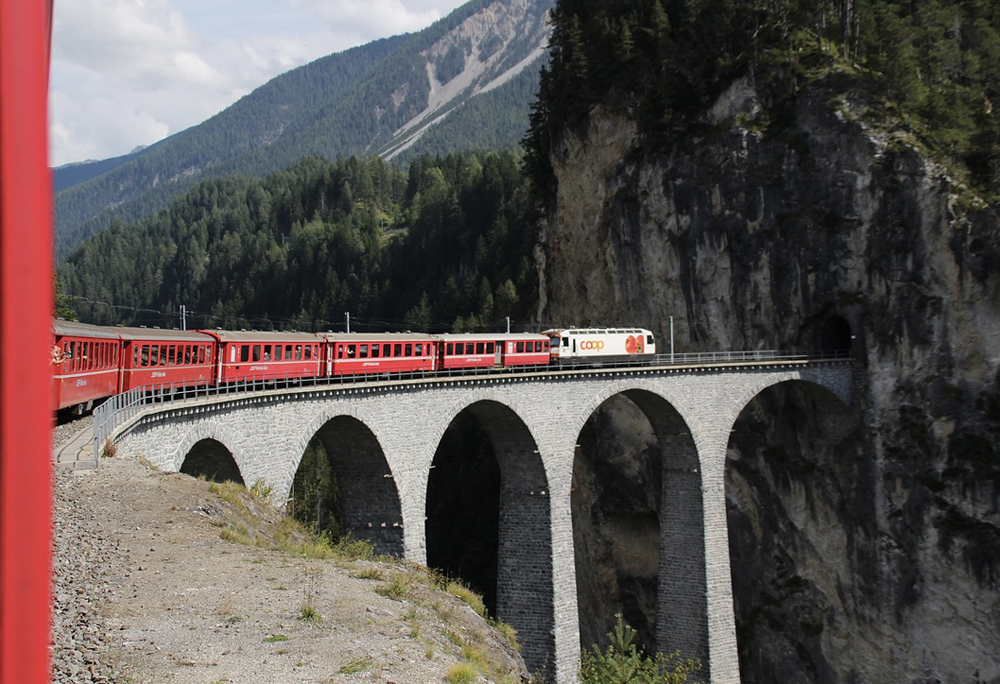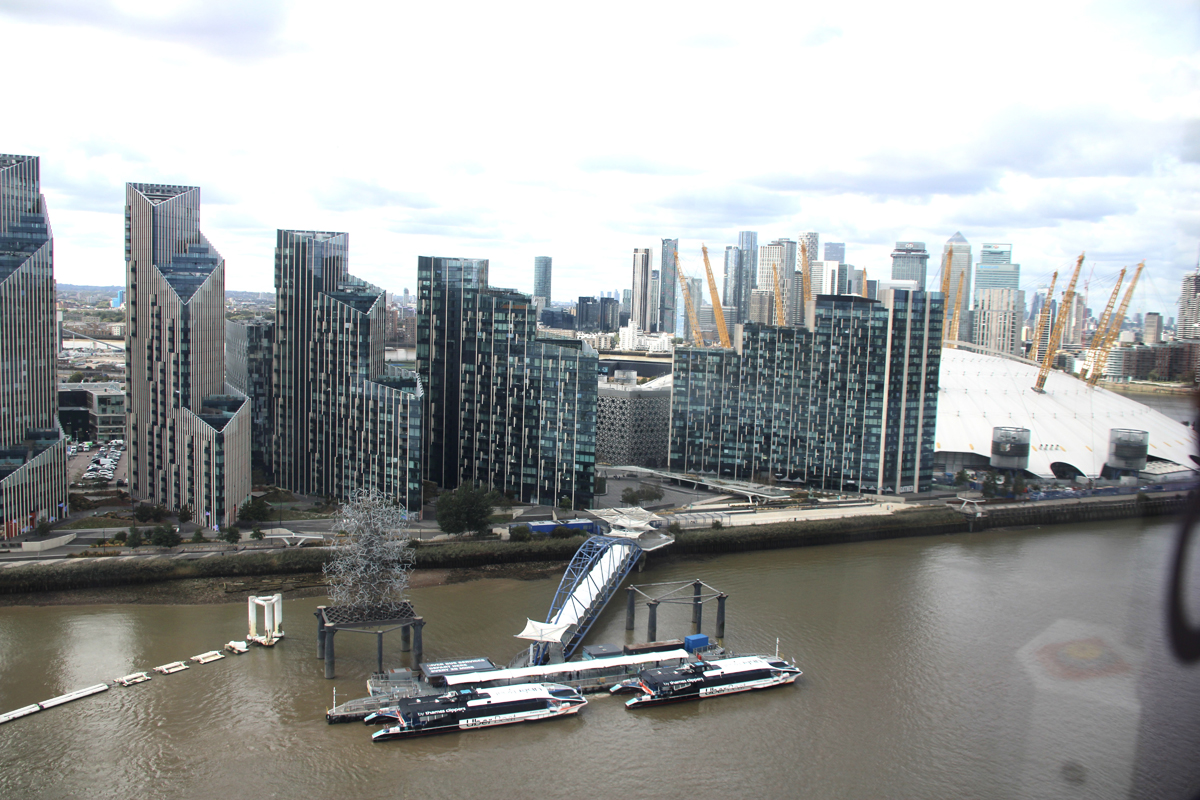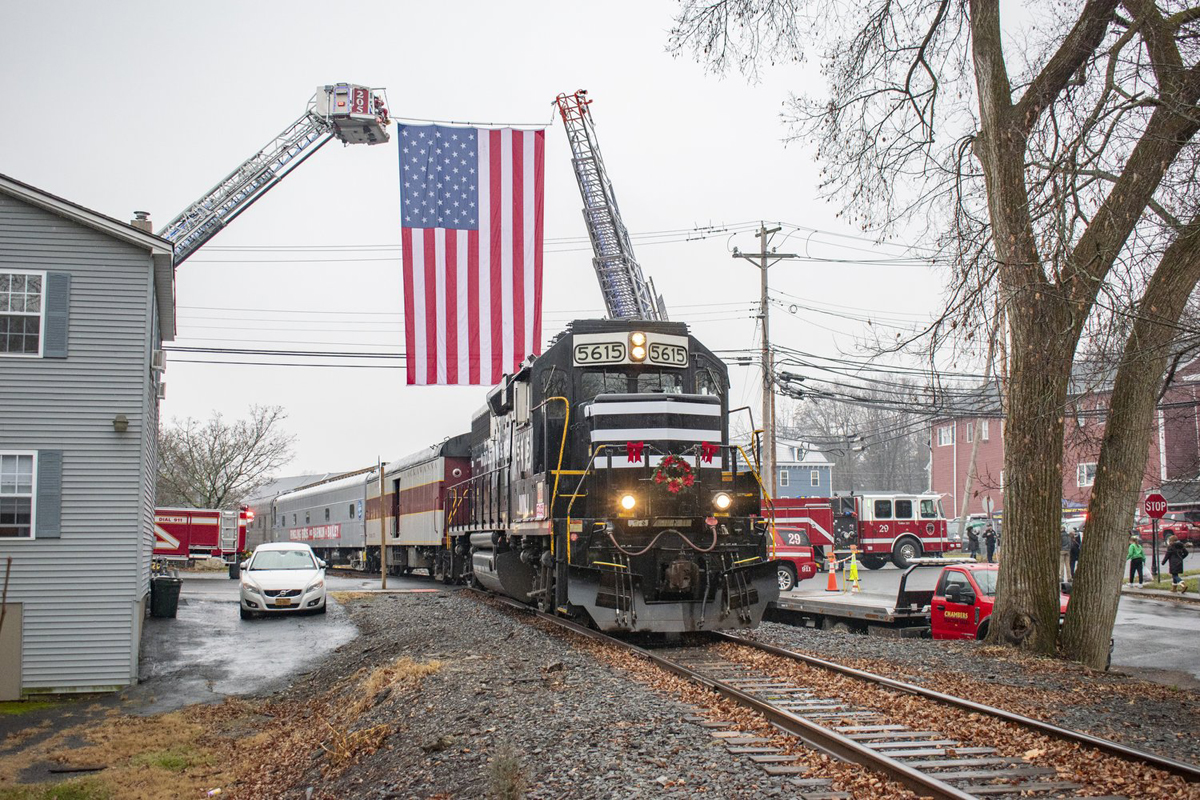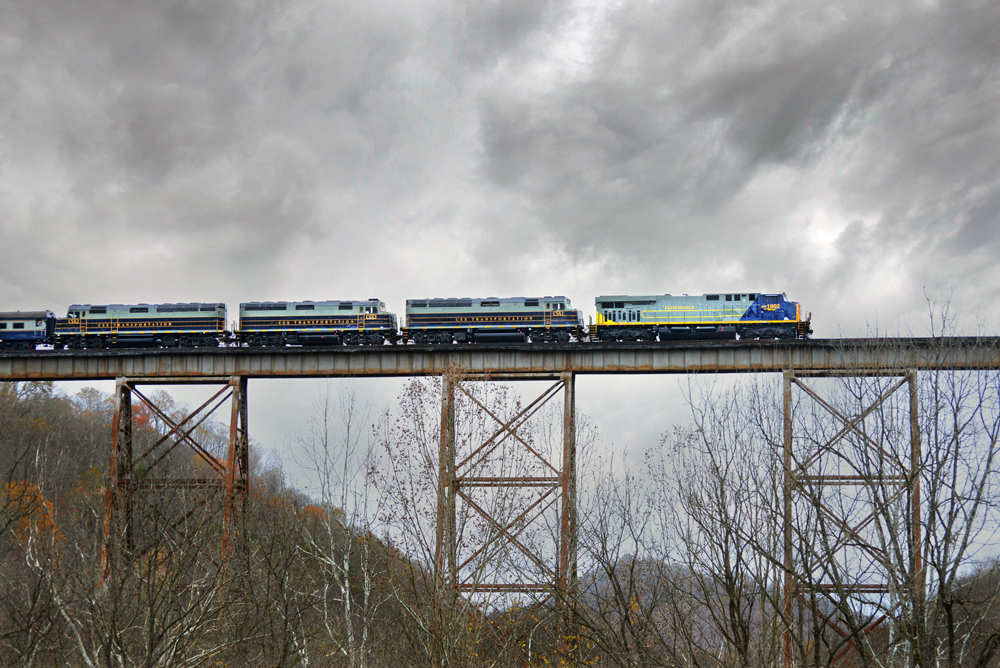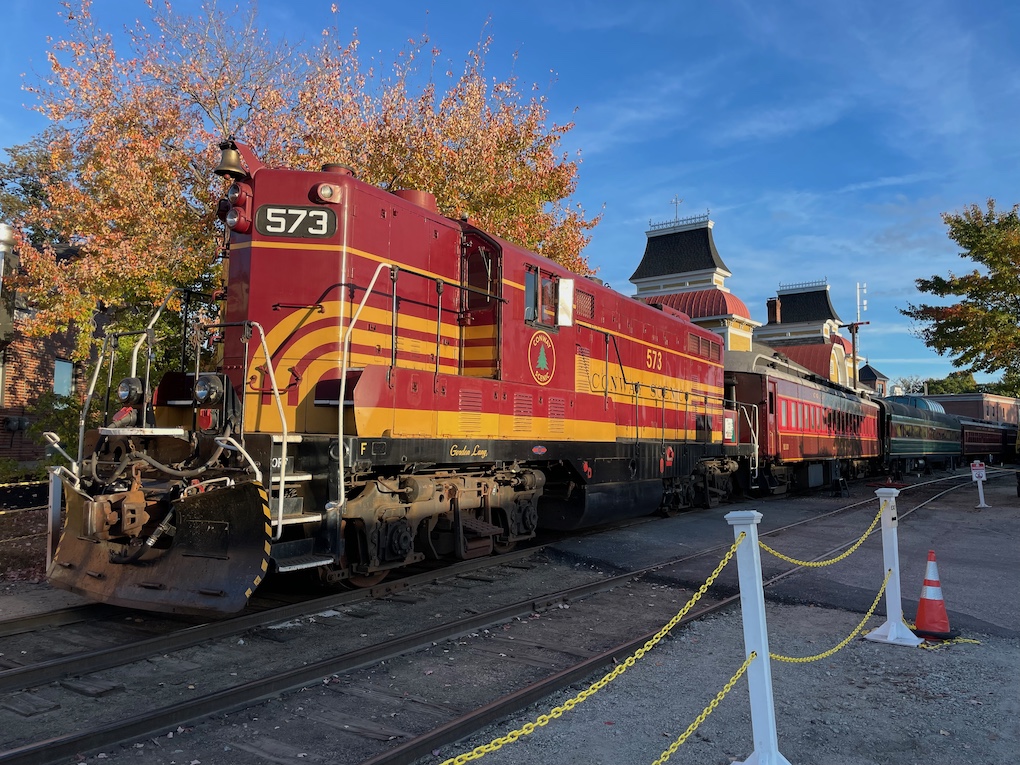
The Trains New England Fall Colors by Rail tour checks a lot of boxes. Memorable train rides, great food and lodging, colorful fall foliage, and time to explore picturesque towns. What’s it like to visit New England with Trains Magazine? Follow along with this day-by-day journal from Editor Carl Swanson.
Friday, Oct. 4th, 2024
Volunteering to host the week-long New England Fall Colors by Rail tour was an easy decision. The Mount Washington Cog Railway, Maine’s two-footers, Conway Scenic, and much more would all be new experiences for me. The itinerary even included a visit to Maine’s Acadia National Park.
Two fairly short flights separated by a brief layover delivered me to Portland in the early afternoon. Our hotel, a Hyatt Place, was in the city’s historic Old Port district, which has cobblestone streets, ancient brick buildings, trendy shops, and very crowded sidewalks. Fall colors in New England, I was beginning to understand, means plenty of sightseers. Not a problem for us — all our rail adventures on this trip would involve blocks of reserved premium seats, or private railcars, or even entire trains. Forget the crowds, our group would have plenty of elbow room.
At 4:30, I met our group in the hotel lobby. Ten couples, two tour coordinators from our travel partner, Special Interest Tours, and me. We walked from the hotel to the docks, about a 10-minute stroll where we were divided between two boats for a sunset cruise of the Portland waterfront and Casco Bay. It was cloudy and cool, and our boat gently rolled in a swell coming off the Atlantic. The boat charter host pointed out the sights, answered questions, and served beer. Our opening activity had nothing to do with railroads, but this is Maine. You gotta get on the water!
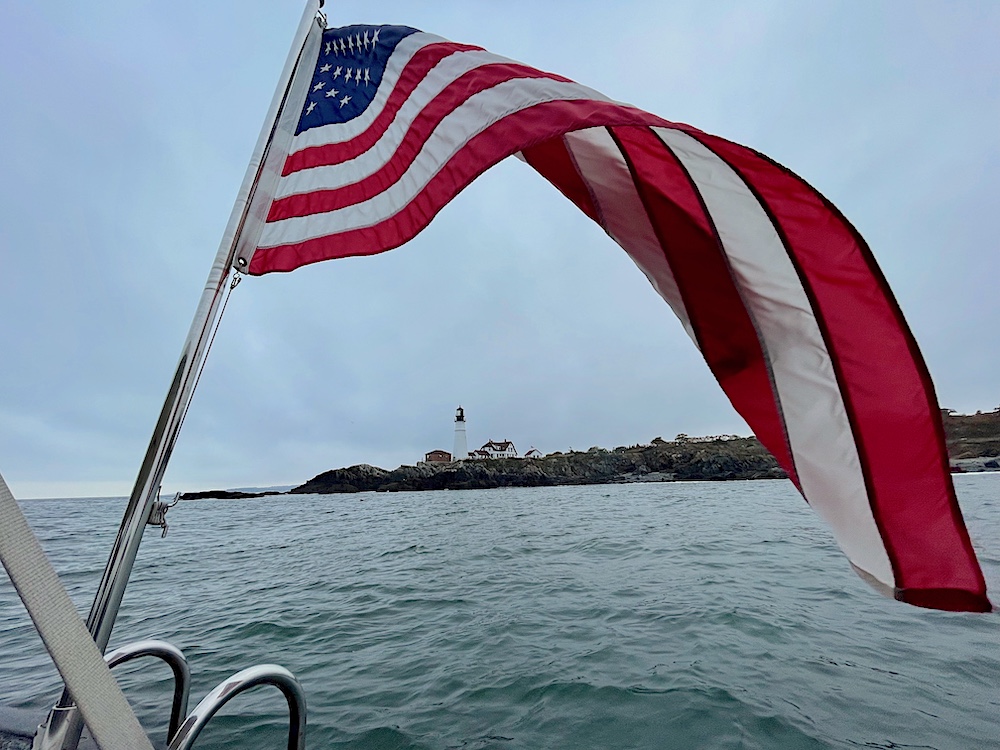
It was a nice way to see another side of Portland, everything from lobster boats to a cruise ship, and from seaside mansions to historic lighthouses. After 90 minutes, the boats delivered us back to the dock and we strolled over to DiMillo’s on the Water, a large and popular restaurant. Our group had a private dining room reserved and the food and drink were promptly supplied in heroic quantities. The first course was clam chowder. I’ve never tried it, on the grounds clam chowder sounds absolutely disgusting. Well, when in Rome, do as the Romans do. Using the tip of my spoon, I cautiously sampled it. Delicious. I mopped up the rest of bowl in a flash. Nice to try new things.
Saturday, Oct. 5th
First thing in the morning we gathered on the sidewalk to meet the driver of the motor coach we had charted for the week. Lem Parker proved both a great guy and an expert at smoothly piloting a tour bus through New England’s occasionally narrow and perpetually busy roads. He got right to work taking us to the Seashore Trolley Museum in Kennebunkport, Maine.
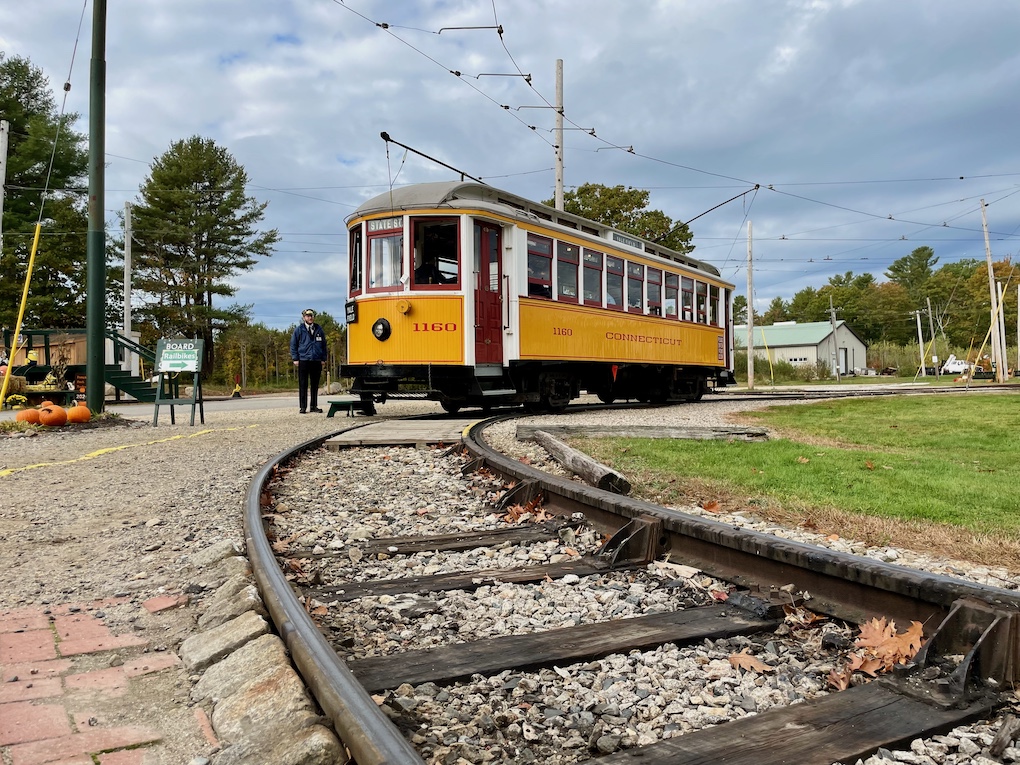
We had chartered a beautifully restored trolley car for our group, No. 1160, a 30-foot car built for the Connecticut Company. We were visiting on a sunny and warm Saturday when the museum was hosting a special event — running trains to a pumpkin patch. The museum was overrun but not in our car!
There was a short delay getting us out of the station and the conductor used the time to explain the history and unusual features of our trolley. The interior lacked the usual two-by-two seating. Instead, it had longitudinal bench seating on both sides of the car running from front to back. The idea was to free up the center of the car to maximize room for standees.
Finally, the dispatcher radioed that we were cleared to the Restoration Shop — which we could see from our car since the building was all of 300 yards down the track. The conductor lifted the handheld radio to reply, but before he could say anything, one of our tour participants asked in an innocent tone, “Do you know the way?” The conductor returned a mock glare.
Museum staff were waiting to give us a behind-the-scenes tour of the shop. The museum has more than 300 pieces of rolling stock in its collection and while many cars have been restored, the bulk of the collection is stored outside where the weather is taking a toil, poising a serious ongoing challenge.
When we returned to our car, we discovered it half-filled with young families who, confused by where they should go, had boarded in our absence. Well, there was room for everyone if we all bunched together. We trundled the whole length of the line, passing the pumpkin patch without stopping, rounded a turnback loop, and returned to the station where we disembarked, leaving the families to finally get on their way to their pumpkins. We reboarded our bus for free time in Kennebunkport.
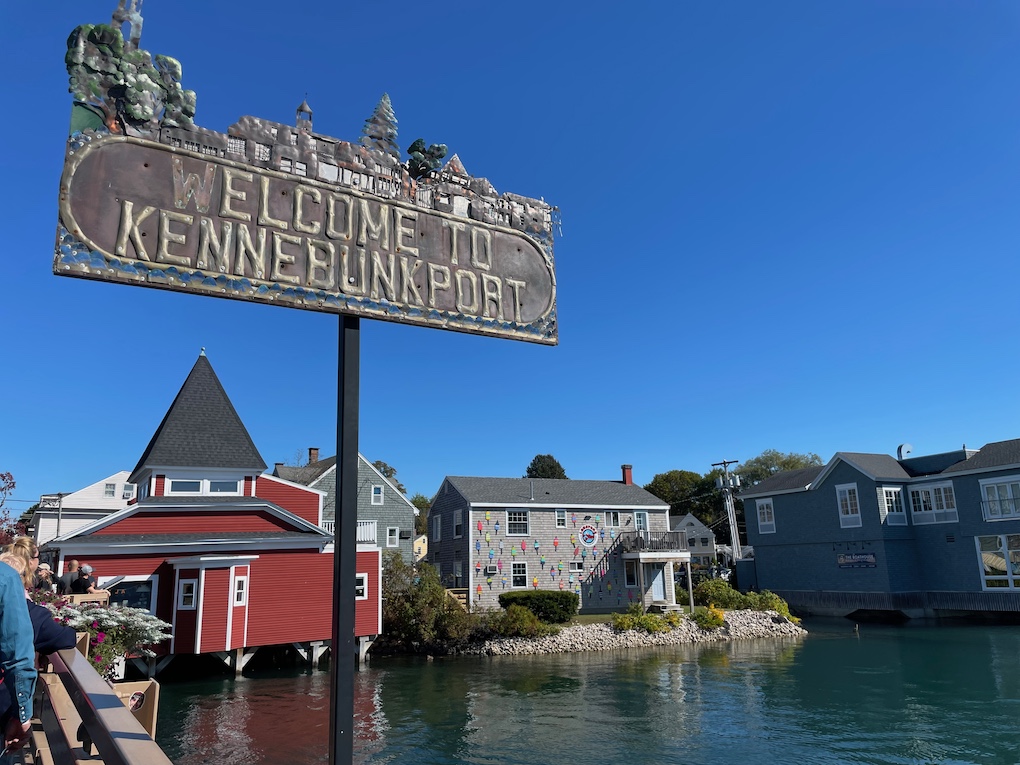
Kennebunkport on a nice fall weekend is a popular place. Bumper-to-bumper traffic inching along a narrow main street, between sidewalks solidly packed with people. The lobster roll stand had a line 60 deep. But Federal Jack’s Brewpub proved a good choice for a sandwich and, a quiet beer. I looked in at a few shops, before strolling back to our designated pickup spot.
From Kennebunkport we drove to New Hampshire and the Winnipesaukee Scenic Railroad’s “Turkey Dinner Train.” It’s like Thanksgiving on rails with turkey and all the trimmings served over the course of a leisurely ride along the western shore of Lake Winnipesaukee, New Hampshire’s largest lake. The lake is scenic, and the summer homes that line the shore are impressive. The train was extremely popular, but we had reserved an entire dining car so all of us enjoyed lake-view seating. I wasn’t sure about the idea of a turkey train, but the dinner was good and there was certainly a lot of it.
Then it was back on the bus and on through the gathering dusk to Lake Opechee (pronounced “Oh peachy”) Inn & Spa. We would spend three nights here and it was a treat not having to pack each morning. My room was large and came with a fireplace, balcony, and arched ceiling.
Sunday, Oct. 6th
Our destination today was the Conway Scenic Railroad, where we had two trips booked. The railroad was having an exceptionally busy day — a warm and sunny weekend day at the height of fall colors. Go figure. First up: a hour-long round trip on the Conway Valley Flyer. We had reserved an entire car, the Gertrude Emma, an 1890s Pullman parlor car, believed to be the oldest in regular service. A full-sized railcar gave our 23 people plenty of room to spread out. Now this is traveling in style!
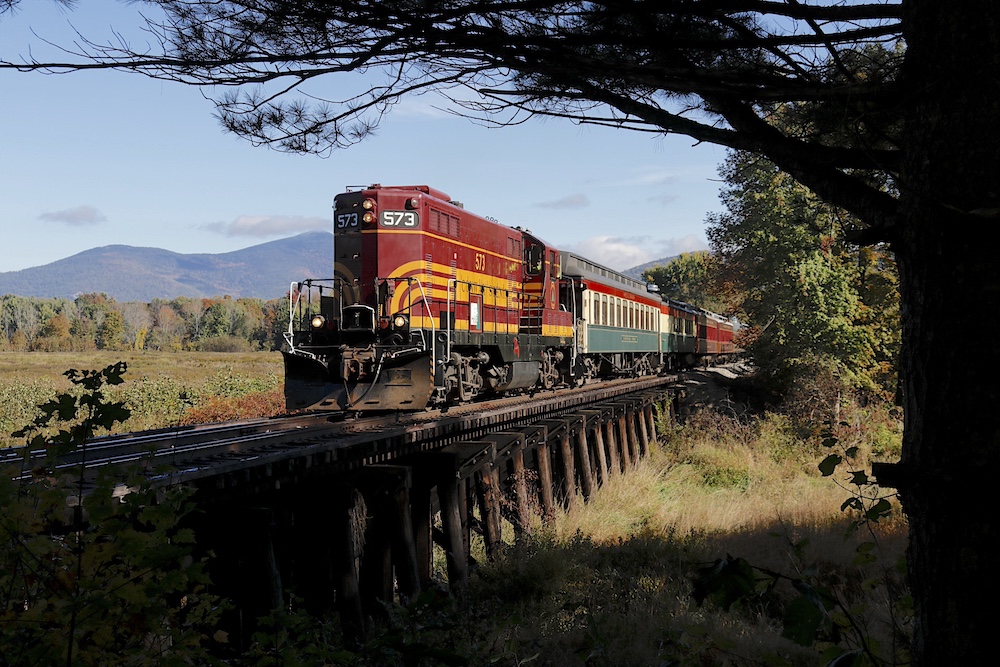
Brain Solomon, Conway Scenic’s marketing manager (and a Trains columnist) arranged a surprise. He asked a maintenance crew cut back vegetation at Moat Creek Bridge and arranged for our train to stop and disembark our group for a quick photo runby. Thanks Brian!
Back at the station, we awaited the 11:15 departure of the Mountaineer for a 5-hour round trip to Crawford Notch. The station was a shoulder-to-shoulder crush but we were boarded quickly and bag lunches were handed around. We didn’t have a private car this time, but we did reserve the entire dome. It’s a scenic ride and we had excellent views from our lofty perch.
We rumbled along through a tunnel of trees. It was very pretty with the changing leaves. The nice, long train ride gave me plenty of time to wonder what Crawford Notch is supposed to be, and why it’s such a draw. I was aware we were climbing a long and fairly stiff grade. Then we broke out of the trees high up on a mountainside.
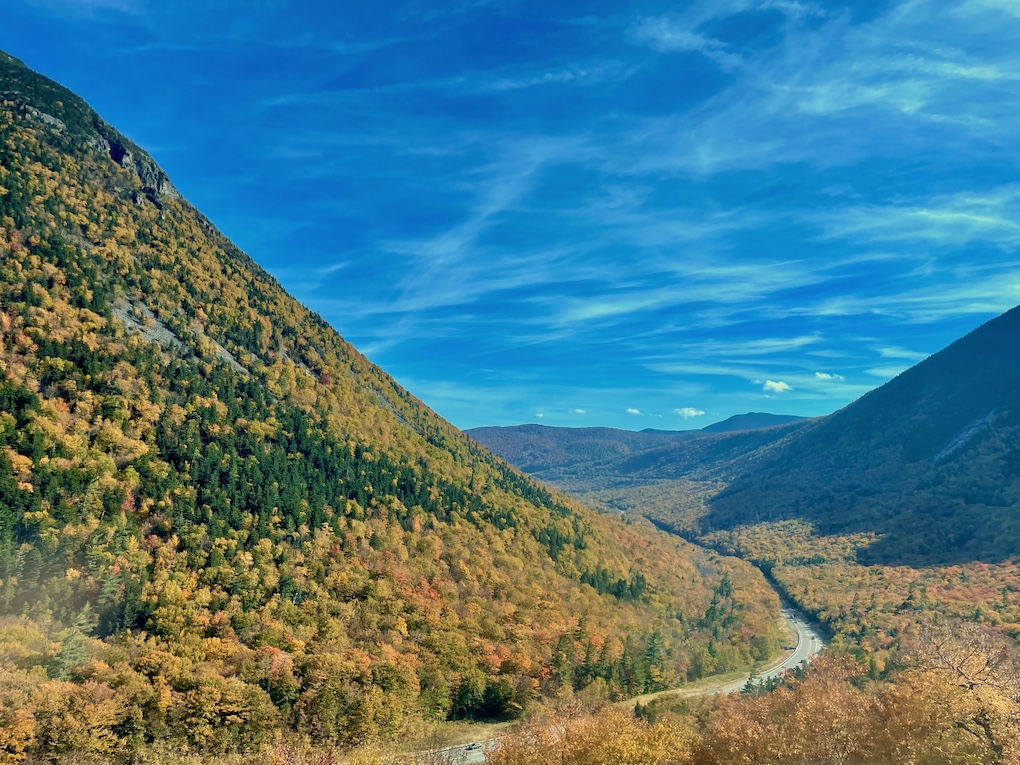
One of our group exclaimed, “It’s like the Durango & Silverton!” It had been all flatlands on this trip until now. I knew New Hampshire has mountains, but it was amazing to pop out of the forest and find yourself high above the valley on a rocky slope and still grinding uphill.
Now I know what all the fuss is about. The Notch is a popular destination for hikers, sightseers, and motorcycle and sports car owners out for a scenic drive. It was a sea of cars, buses, and people, which was odd, you know, for a wilderness.
After a layover at the summit passenger station, we started homeward, rocking gently downgrade, into the woods, and finally arrived back in Conway where a pair of volunteers were waiting to give us a behind-the-scenes tour of the roundhouse. They have a steam locomotive nearing its return to service. It would be worth seeing it cross the bridge at Moat Creek — especially if we can get a runby!
Monday, Oct. 7th
This was a day I’d been anticipating for a long time. We were on the bus and headed for the Mt. Washington Cog Railway. On arrival we had a little time to mill around the station at the base, which has a small museum and a gift shop. There’s a weather observatory at the summit of Mt. Washington, and a monitor over the ticket desk showed the current conditions at the summit, which on this day was 34 degrees — it is usually about 30 degrees cooler than the base of the mountain. Something to consider in packing for this trip (I hadn’t considered it).
Bag lunches in hand, we trooped out to our train. Yes, we reserved an entire train but that’s not as impressive as it sounds. All the trains, and I believe there were five running on the day we visited, consist of one car and one locomotive (they have seven new biodiesel locomotives but still maintain two steam engines). Before departure, we had time to inspect one of the steam locomotives and listen to a talk from cog employee on the railroad’s motive power. He was friendly and informative.
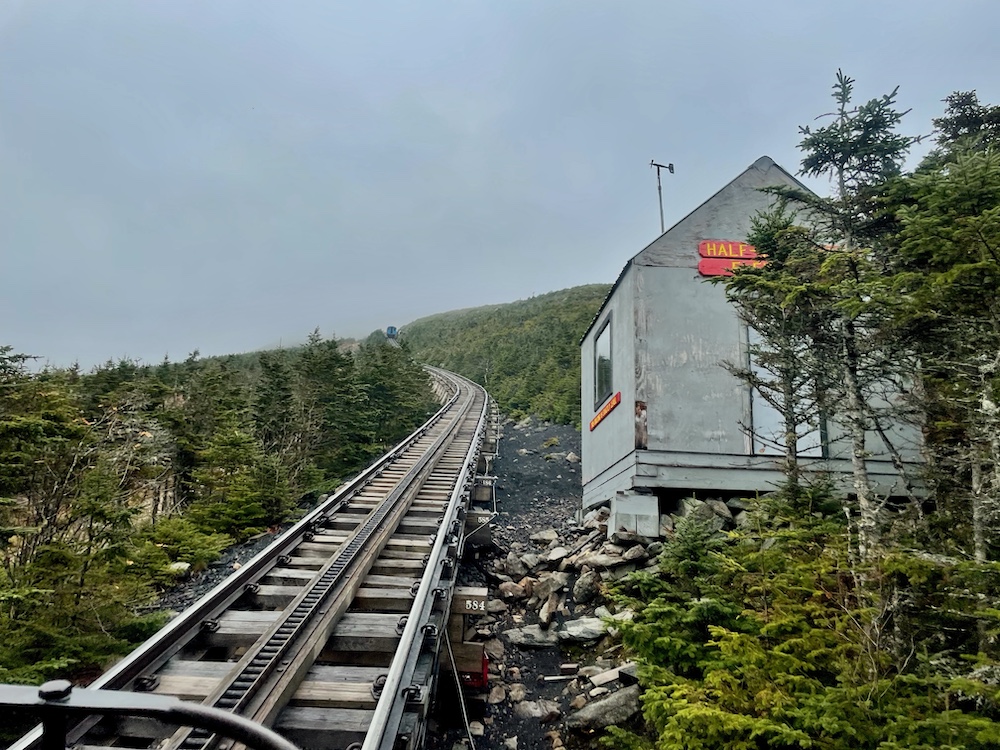
We settled into our coach and the procession of trains (they run them in batches) started up the highest mountain — at 6,288 feet — in the Northeastern U.S. It’s often said to have the worst weather in the world. The highest wind speed ever recorded was here — 231 mph before the anemometer was blown off the mountain. The grade tops out at 35% and we tackled it at 5 miles an hour. We soon climbed above the tree line and straight into a cloud.
They give riders an hour at the top to look around and enjoy the view (non-existent today). It was eerie in the dense fog. You could hear many people around you, but only saw them when they were fairly close. A look through the weather observatory’s little museum was worthwhile and its admission was included in the cog railway fare.
Soon we reboarded and headed down the mountain. The cog railway is enjoyable and worth doing, rain or shine, or fog. But probably not when the wind is blowing at 231 mph! Back in the motor coach, we rumbled through the countryside for an hour to the Cafe Lafayette Dinner Train, which operates on the tracks of the Hobo Railroad. Again, we had reserved the entire dome for our group. This was a fancy train, with tablecloths, candles, and multiple courses.
Tuesday, Oct. 8th
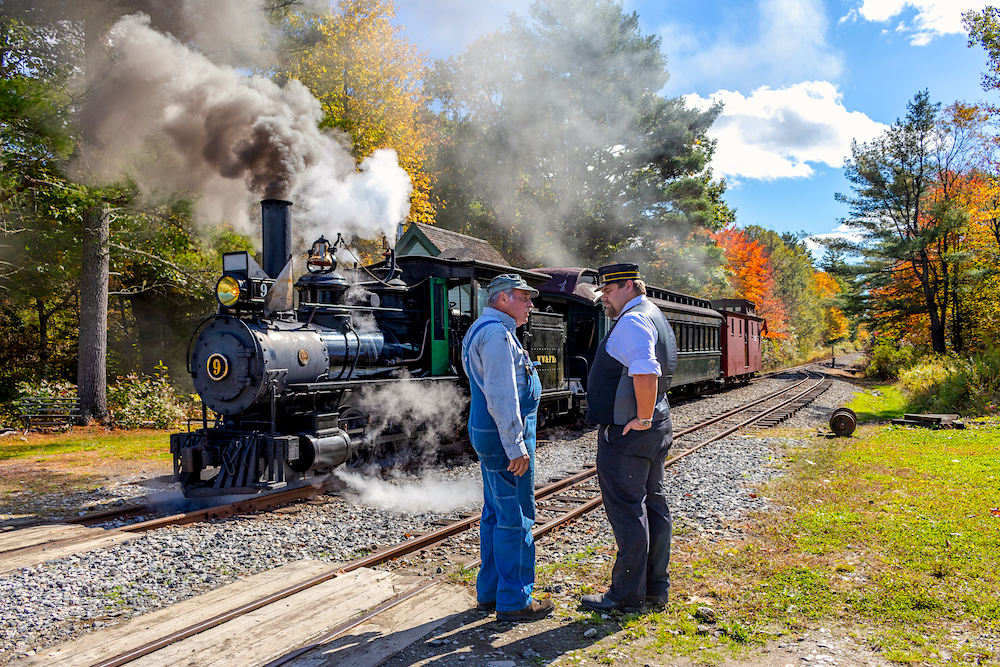
We checked out of the Opechee Inn and Lem drove us back to Maine and an appointment with the 2-foot gauge Wiscasset, Waterville & Farmington, a surviving part of Maine’s once-extensive 2-foot lines. We had a chartered steam train waiting for us. After a stop for lunch at a picnic pavilion in the woods, we enjoyed a quick photo runby before resuming our out-and-back trip. I was happy to see our tour participants getting the hang of it, forming an orderly line, and reminding each other to be quiet in case anyone was shooting video. Give these guys another trip or two and we’ll make them into proper foamers!
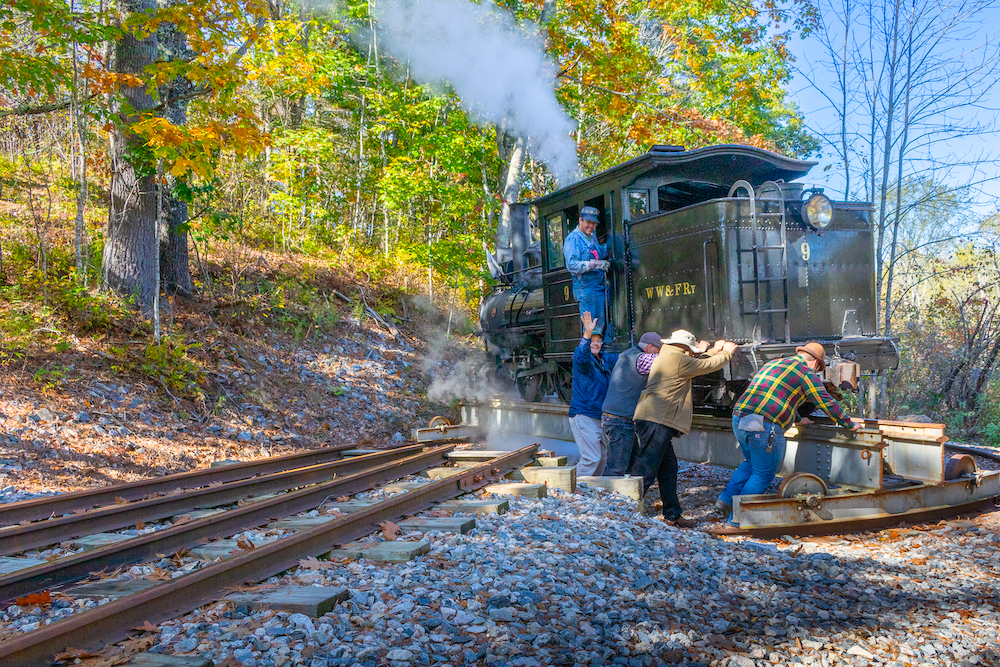
We reached the end of the line, which terminated at an armstrong (i.e., manually operated) turntable. The steam engine uncoupled and moved onto the turntable bridge, and the crew called for volunteers. Some men from our tour stepped up and, with their wives cheering them on, turned the locomotive. Fun! Everything about this railroad was neat, clean, well-organized, and friendly. They gave us a shop tour and, unsurprisingly, their workshop was equally tidy.
Boothbay Railway Village Museum was our final stop before heading to the next hotel. You’ve probably seen places like this: They drag in a depot from here, a church from there, a one-room schoolhouse, a barn, a town hall, etc. The buildings are arranged to look like an old-timey village, with all the buildings being mini museums. We had arranged for a lobster bake dinner here. Obviously, a very Maine sort of thing. They served plates holding an entire lobster, a piece of fried chicken, roll, and coleslaw. I had my doubts. The idea was to rip it apart with your bare hands and pick out bits to eat with your fingers. It was more than I wanted to deal with so I asked for a plate with no lobster, feeling like I was letting the team down.
We had a boutique hotel for the next two nights, the “16 Bayview Hotel” in Camden, Maine. Each room had a balcony, a fireplace, heated marble floors in the bathroom, the works. I could get used to this!
Wednesday, Oct. 9th
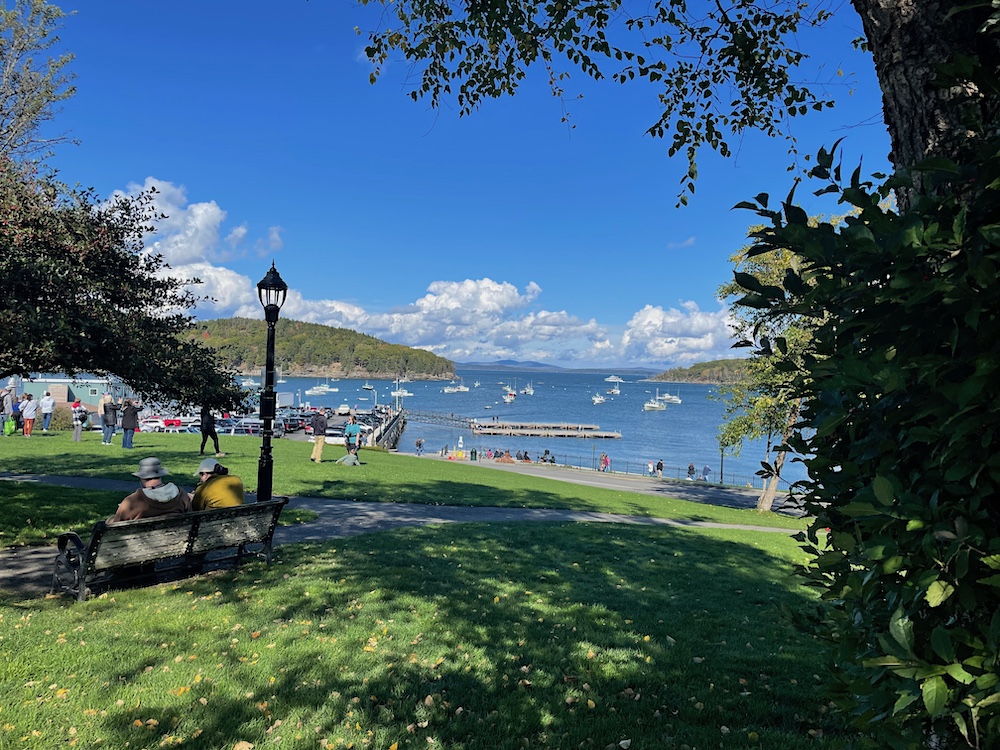
Today was a non-railroad day. Time to explore the resort community of Bar Harbor, Maine, followed by a narrated trolley bus tour of Acadia National Park. Located on an island, Bar Harbor has a permanent population of just over 5,000. Shortly after the Civil War, America’s newly rich embraced Bar Harbor as their summer home. Henry Ford, the Rockefellers, Cornelius Vanderbilt, J.P. Morgan, and many others built elaborate summer homes here.
One of them, John D. Rockefeller, felt the untouched parts of the island were too beautiful to be wrecked by development. He started purchasing land and talked his wealthy friends into joining him. After many hoops, including the need to pass legislation (the Antiquities Act of 1906), they transferred ownership to the government. Arcadia National Park is the result.
Today, the town, hemmed in by the water on two sides and by a national park on the other two sides, remains a popular destination. We boarded a trolley bus for a tour of Acadia National Park. The guide was informative and amusing, although his spiel felt like something he had repeated word-for-word many times. Acadia was packed. They have a timed entry system but the park was still wall-to-wall. We drove along watching waves crash into tall rock cliffs, through forests, and finally arrived at a scenic overlook. Acadia seems remote, yet it is the nation’s seventh most-visited park right after Yosemite. Why? Because many of the largest cities on the East Coast and more 100 million people are within a 12-hour drive. Acadia is worth seeing but the trolley bus tour seems the most reasonable way to do it. I certainly wouldn’t want to drive here. Who wants to fight traffic in a park?
Thursday, Oct. 10th
We checked out of our fancy hotel in Camden and hit the road for a full morning visit to the Belfast & Moosehead Lake Railroad. We had chartered a diesel-powered passenger train. Our crew was friendly and accommodating. Lem was interested in the locomotive and fell into conversation with the engineer — and that’s how our non-railfan bus driver scored a cab ride!
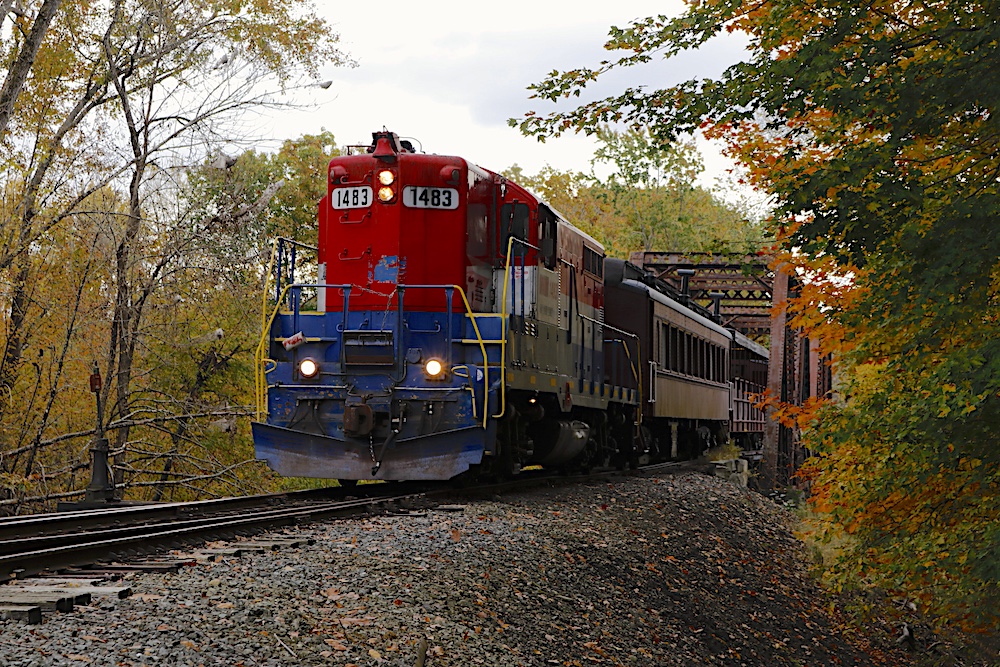
It was a good ride with a great crew and a nice runby at the midway point. The host in the car I was riding was a young lady, cheerful, animated, and full of information about Maine’s wildlife — a passion of hers. At the end of the ride, we walked across the street for lunch at a small-town restaurant.
Hard to believe, but our tour was drawing to a close. We drove back to Portland for a late afternoon ride on the Maine Narrow Gauge, a tourist railroad along the waterfront built to commemorate Maine’s two-foot gauge heritage. We boarded our train, yes, the whole train, and set off. It was a fun little ride and they even gave us a couple of runbys. With the cab the same width as the hood, the engine looked very goofy, like something they built themselves, but is an actual General Electric industrial locomotive from the 1940s, one of only three made.
Our farewell dinner was at Scales, a highly rated seafood restaurant on the waterfront. It was sad saying goodbye. It was a great group of people.
Friday, Oct. 11th
Time to fly! I checked a bag at American Airline’s counter and filed onto the plane, an Airbus something-or-other (an A319? I’m better with trains). They closed the doors, the flight attendant stood to give the safety briefing, and we pushed back. We got about 75 feet from the gate when there was a tremendous lurch and the flight attendant had to grab a seat back to keep from face-planting in the aisle.
The pilot tersely explained we had somehow gotten tangled up with the push-back tug’s tow bar and needed to wait while they checked the damage to the nose landing gear before moving us back to the gate. After an hour they decided to risk the 75-foot journey back to where we had started. I spent the rest of the day in the airport. In the evening, they finally canceled and issued vouchers for a taxi, a hotel, and a meal.
Back at the airport the next day, I needed to spend my meal voucher and ordered a lobster grilled cheese sandwich. So, I finally did eat lobster in Maine — courtesy of American Airlines (sorry about your airplane!) — and made it home, 24 hours late.
Interested in checking out our lineup of upcoming tours? Visit Special Interest Tours for more information and specifics on planned itineraries. Read Carl Swanson’s report on the Trains Alaska Tour here.






